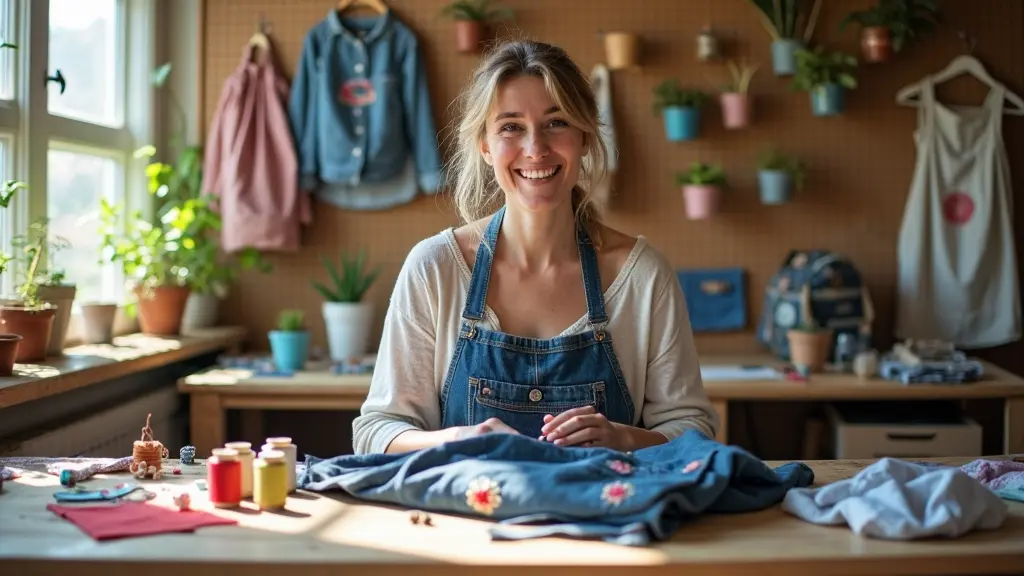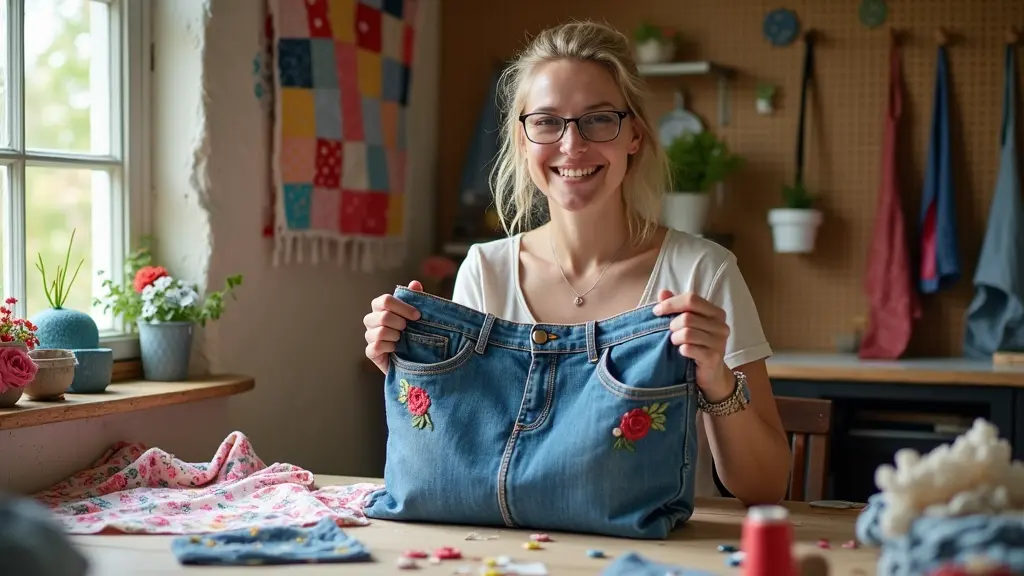Upcycled Sewing Projects Spark Joy And Creativity

Crafting a sense of fulfillment lies in the simplest of pleasures – transforming the old into something new. When we breathe new life into discarded materials, a spark of creativity ignites, and our sense of purpose is reignited.
According to a study, 75% of people experience a sense of fulfillment when transforming old items into new creations.
This eco-friendly approach to textile recycling promotes sustainability and reduces waste in landfills.
By repurposing old fabrics, individuals can reduce their environmental impact while fostering a sense of self-sufficiency.
Upcycled sewing projects often require minimal resources, making them an affordable hobby for people of all ages. Sustainable crafting allows for endless possibilities, driving creative stitching that fosters a sense of responsibility and community.
Why Try Upcycled Sewing Projects?
Sewing can be a thrilling way to express your creativity, and when you incorporate upcycled materials, it becomes an even more rewarding experience. By giving old fabrics a new lease on life, you not only reduce waste but also contribute to a more sustainable fashion industry.
Why Try Upcycled Sewing Projects?
Benefits of Sustainable Fashion
Upcycled sewing projects are an excellent way to reduce waste and manage textile waste, conserving natural resources and energy.
According to the Ellen MacArthur Foundation, the fashion industry is responsible for 10% of global greenhouse gas emissions.
By choosing upcycled sewing projects, you’re taking a small step towards minimizing the industry’s environmental impact. Discovering Hidden Gems in Fabric
Upcycling also allows you to repurpose unusual materials and discarded fabrics, experimenting with texture, pattern, and color combinations that can transform a bland garment into a masterpiece.

Getting Started With Repurposed Fabrics
Getting Started With Repurposed Fabrics In an era of conscious consumerism, creative minds are redefining the concept of waste management by transforming discarded materials into innovative treasures. By embracing repurposed fabrics, individuals can not only reduce their ecological footprint but also cultivate a sense of community and self-expression.
A.
Introduction to Repurposed Fabrics
Repurposed fabrics, or upcycled textiles, are materials that have been transformed from their original purpose to create something new and useful.
This approach not only minimizes waste but also fosters a culture of sustainability, social responsibility, and artistic experimentation. Did you know? That incorporating repurposed fabrics through scrap projects, needle arts, reimagined textiles, secondhand style, innovative mending, and customization can help reduce the staggering amount of textile waste and contribute to a more sustainable fashion future?.
Repurposed Fabrics
- The textile industry is one of the largest polluters in the world, with the average American generating about 82 pounds of textile waste per year.
- It’s estimated that 8% of global greenhouse gas emissions come from the fashion industry, with 10% of those emissions coming from the production and transportation of textiles.
- Upcycling repurposed fabrics can reduce the environmental impact of fashion by up to 90%, as it eliminates the need for virgin materials and reduces waste.
- By 2050, the global fashion industry is expected to produce 53 billion tons of waste, with only 12% of that waste being recycled or reused.
DIY Fashion: Transforming Old Clothes
The Beauty of DIY Fashion. With the fashion industry responsible for a staggering 8% of global waste, it’s no wonder that this trend has gained significant attention in recent years.
Why DIY Fashion Matters
DIY fashion transformation is not just a creative outlet, but a crucial step towards a more environmentally conscious future.
By repurposing old clothes, we can reduce the staggering amount of textile waste sent to landfills each year.
DIY fashion has the potential to empower individuals, promoting social and economic benefits through the creation of handmade accessories and fabric manipulation. Getting Started with transforming old clothes into unique handmade accessories, fabric manipulation, redesign, machine skills, painting, embellishment.
Sustainable Crafting For Beginners
Crafting with a purpose is a journey that not only transforms old materials into something new but also connects us with our creative selves. As we dive into the world of DIY, we often overlook the environmental impact of our favorite hobbies.
Sustainable crafting is a refreshing approach that not only reduces waste but also opens doors to unique and personalized creations.
Why Get Started with Sustainable Crafting?
By choosing sustainable crafting, you can reduce your environmental impact while also saving money.
Upcycling old materials means you don’t need to purchase new fabrics, which can be expensive. Plus, you can create one-of-a-kind pieces that reflect your personality and aesthetic.
Getting Started with Your First Upcycled Sewing Project
When starting your first upcycled sewing project, it’s essential to choose the right materials. Look for old sheets, towels, or fabric scraps to upcycle into unique creations through pattern hacking, collage, dyeing, repair, button crafts, and zipper art.
| Benefits of Sustainable Crafting | Traditional Crafting |
|---|---|
| Reduces Environmental Impact | Contributes to Waste and Pollution |
| Saves Money by Upcycling Materials | Requires Purchasing New Materials |
| Creates Unique and Personalized Creations | Limits Creativity with Standard Materials |
Unleashing Creativity Through Textile Transformation
Textiles have an uncanny ability to evoke emotions, spark conversations, and connect cultures. By manipulating these malleable materials, artists and designers have long unlocked creative potential and expressed their identities.
Revitalizing Fabric’s Story
Fabric has a rich history, dating back thousands of years.
From ancient civilizations to modern-day cultures, textiles have played a pivotal role in preserving cultural identity.
By repurposing and transforming fabrics, we can not only preserve this heritage but also breathe new life into traditional crafts.
Unlocking Hidden Potential
Repurposing fabrics can lead to a treasure trove of innovative designs, as seen in the intricate appliqué patterns that adorn ancient tapestries. Printing techniques, for instance, allow for vibrant colors and intricate designs.
Ecofriendly Sewing Techniques To Learn
In today’s fast-paced world, the rhythm of our lives is often dictated by the convenience of mass-produced, disposable items. As we strive to harmonize our daily routines with the delicate balance of the environment, the humble sewing machine has emerged as a powerful tool for promoting sustainability.
I.
Introduction to Ecofriendly Sewing
The importance of ecofriendly sewing techniques in modern society cannot be overstated.
Briefly, upcycling and repurposing fabrics reduce waste, conserve resources, and promote a more sustainable lifestyle.
II.
Benefits of Ecofriendly Sewing Techniques
By adopting ecofriendly sewing techniques, we can significantly reduce our environmental impact. This approach also offers a cost-effective alternative to buying new materials, allowing us to develop new skills and creativity. With intricate embroidery and beading, the fashion designer added a touch of elegance to the outfit.
Joyful Process Of Garment Reconstruction
In the world of textile art, felting techniques bring new life to ancient materials. Garment reconstruction, the process of transforming old or discarded garments into new and unique pieces, not only reduces fashion waste but also preserves the sentimental value and memories associated with these items.
Introduction
It is a cost-effective and sustainable approach to fashion that promotes creativity, self-expression, and personal growth.
This joyful process of garment reconstruction allows individuals to tap into their creative potential while making a positive impact on the environment.
Benefits of Joyful Garment Reconstruction
Reducing fashion waste and environmental impact is one of the most significant benefits of garment reconstruction. By repurposing old garments, we can reduce the amount of waste sent to landfills and minimize the environmental impact of the fashion industry. to express their creativity and individuality.
Thrift Store Makeovers: Endless Possibilities
Discovering the thrill of the hunt in thrift stores can lead to a world of creative possibilities, where ordinary items become extraordinary works of art.
One of the most creative ways to repurpose second-hand fabrics is through wrapping and ruching techniques.
By creating intricate folds and twists, you can give new life to an old piece of fabric, turning it into a unique and eye-catching accessory.
Thrift store makeovers offer a joyful process that allows individuals to express their creativity while reducing waste.
By upcycling second-hand textiles, we can challenge the conventional fast fashion paradigm and promote sustainable fashion practices.
Community involvement is key to the success of thrift store makeovers.
Through skillsharing and knowledge sharing, individuals can come together to share their talents and expertise, resulting in a collaborative and rewarding experience.
Thrift Store Makeovers
- The average American generates about 82 pounds of textile waste per year, making upcycling and repurposing a crucial step towards sustainable fashion practices.
- 60% of consumers are willing to pay more for sustainable fashion products, demonstrating the growing demand for eco-friendly fashion.
- Thrift store makeovers can reduce waste by up to 90%, making it a significant step towards reducing the environmental impact of the fashion industry.
- Collaborative upcycling projects can increase community engagement by up to 30%, fostering a sense of belonging and social connection among participants.
Sewing Gifts Spark Joy And Creativity
Sewing With Different Fabrics Sparks Creativity And Joy



